Art galleries and artists
Leon Bakst (Leib-Chaim Izrailevich Rosenberg, 1866-1924) was born in Grodno in a wealthy Jewish family.
Even as a child, he showed an interest in fine arts and in 1882 he tried to enter the Imperial Academy of Arts, but did not pass the competition. The second attempt was successful and in 1883 the young man became a volunteer at the Academy.
In 1887, the young artist was forced to leave the Academy because of the scandal caused by the painting "Lamentation of Christ" submitted by him to the Academic competition, in which the Virgin Mary was depicted as an elderly Jewish woman with eyes red from tears.
In 1889, Leib-Chaim Rosenberg took part in an exhibition of young artists under the pseudonym Bakst. This is how the future master of theatrical graphics, Leon Bakst, appeared.
In 1890 he began to study watercolor technique under the guidance of Albert Nikolaevich Benois, an academician and teacher of watercolor painting at the Academy of Arts.
In 1893, Bakst went to Paris, where he studied at the famous Académie Julian and the studio famous artist Jean-Leon Gérome.
In 1895 the artist returned to Russia.
In 1898 he became a member of the Neva Pickwickians, which included Alexander Nikolaevich Benois, Konstantin Andreevich Somov, Dmitry Vladimirovich Filosofov and Walter Fedorovich Nouvel. Later Sergei Pavlovich Diaghilev joined the association. It was he who insisted on renaming the association to "World of Art" and founding a magazine with the same name.
Participation in the "World of Art" brought fame to Leon Bakst, he got fans and customers.
Under the influence of the industrialist and philanthropist Savva Mamontov, the members of the World of Art association became interested in theatrical performances, and in the early 1900s, Bakst began to create scenery and costumes for the productions of the Hermitage Theater in St. Petersburg.
In 1906, Bakst took part in the exhibition "Two Centuries of Russian Painting and Sculpture" held in Paris, which was a huge success.
In 1909, at the invitation of Diaghilev, Bakst moved to Paris and, together with Alexandre Benois, began to work on the creation of costumes and scenery for the productions of the Diaghilev ballet troupe.
In 1914 Bakst was elected a member of the Academy of Arts.
Bakst took an active part in the work on the sets and costumes for the ballets The Firebird (1910), Cleopatra (1910), Scheherazade (1910), Carnival (1910), The Vision of the Rose (1911), "Narcissus" (1911), "Tamar" (1912), "Daphnis and Chloe" (1912), "Afternoon of a Faun" (1912), "The Blue God" (1912), "Games" (1913), "The Legend of Joseph (1914), Women in a Good Mood (1917), Tommasini (1917), Sleeping Beauty (1921).
Leon Bakst died on December 28, 1924.
The works of Leon Bakst can be seen in
|
Self-portrait. 1893 |
Paintings and drawings by Lev Bakst:
Biography of Lev Bakst
Bakst Lev Samoilovich(real name - Rosenberg Leib-Khaim Izrailevich) (1866–1924), Russian artist and set designer
Born in Grodno in 1866 in the family of a small businessman. He studied at the gymnasium, four was a volunteer at the Academy of Arts, but, disappointed in academic preparation, left this institution. He was engaged in painting on his own, moonlighting as an illustrator of children's books and magazines.
He presented his works for the first time at an exhibition in 1889, adopting the abbreviated surname of his maternal grandmother (Baxter) as a pseudonym.
In the early 1890s, he exhibited his works, mostly landscapes, at the Society of Watercolorists. From the mid-1890s, he joined the circle of writers and artists who united around S. Diaghilev and A. Benois, and later became one of the initiators of the creation of the "World of Art".
It was graphic works for the magazine "World of Art" that brought Bakst wide popularity. Bakst introduced the wavy line of Art Nouveau and an almost oriental predilection for planar drawing and bright colors to the world of gardens, architectural perspectives and flowing draperies, beloved by artists close to the World of Art.
The artist continued to work and easel painting, performing many graphic and pictorial portraits of famous writers and artists - F. Malyavin (1899), V. Rozanov (1901), Andrei Bely (1905), Z. Gippius (1906) and others.
Due to the need to support a family - a widowed mother and young brothers and sisters, Bakst became a drawing teacher for the children of Grand Duke Vladimir, and in 1902 he received an order from the tsar to depict the “Meeting of Russian Sailors” in Paris.
The period from 1893 to 1899 he spent in Paris, while often visiting St. Petersburg.
In 1898, Bakst exhibited at the first exhibition of Russian and Finnish artists organized by S. Diaghilev, and from 1899 he took a constant and active part in the exhibitions of the World of Art, in the Secession exhibitions in Munich, until 1910 - in the exhibitions of the Union Russian Artists”, as well as various art exhibitions in Prague, Venice, Rome, Brussels, Berlin.
During the years of the first Russian revolution, he collaborated with the satirical magazines Zhupel, Infernal Mail and Satyricon, then designed the magazines Golden Fleece and Apollo. He was engaged in book graphics and decorative art, designing interiors and exhibitions.
By the end of the 1900s. Bakst limited himself to work in the theater, thanks to which he entered and went down in history as an outstanding theater artist. He made his debut in the theater back in 1902. Later, the artist made theatrical costumes for artists (for example, for Anna Pavlova).
Bakst became the leading artist of the "Russian Seasons" and "Russian Ballet S. Diaghilev" and created scenery and costumes for such ballet performances as "Cleopatra" (1909), "Scheherazade" and "Carnival" (1910), "Narcissus" (1911) , "Daphnis and Chloe" (1912), etc., striking the audience with their imagination, fabulous luxury, sophisticated sophistication of costumes, new and bold combinations of colors.
All these years, Bakst lived in Europe, which was caused by the need to be near the ballet troupe, as well as the fact that, as a Jew, he did not have a residence permit in St. Petersburg.
In 1914 Bakst was elected a member of the Imperial St. Petersburg Academy of Arts.
The growing tension in the relationship between Bakst and Diaghilev led to the fact that in 1918 the artist was forced to leave the troupe.
He died on December 27, 1924 in Paris from pulmonary edema.
If the artist creates his own unique visual world, the architect creates his own environment, the playwright immerses us in the world of his characters, the composer sets a certain rhythm, then theater artists simply have a global task to unite the creative vision of all participants in the production, while remaining true to themselves and their ideas. about the work.
What, luxurious or minimalist scenography should be on the stage, the artist decides. He knows exactly how to create the illusion of a fictional world, he feels the dramaturgy, determines those means of expression, which would accurately meet the objectives of the performance. Finally, he solves technical issues; with the imperfect construction of the theater, how to correct the angle of inclination of the stage plane to the plane (or, in the professional language of the tablet) of the auditorium, so that the actors do not “sit” on the viewer’s nose; add depth to the scene, take into account all viewpoints, lights, costumes, positions actors at a certain moment.
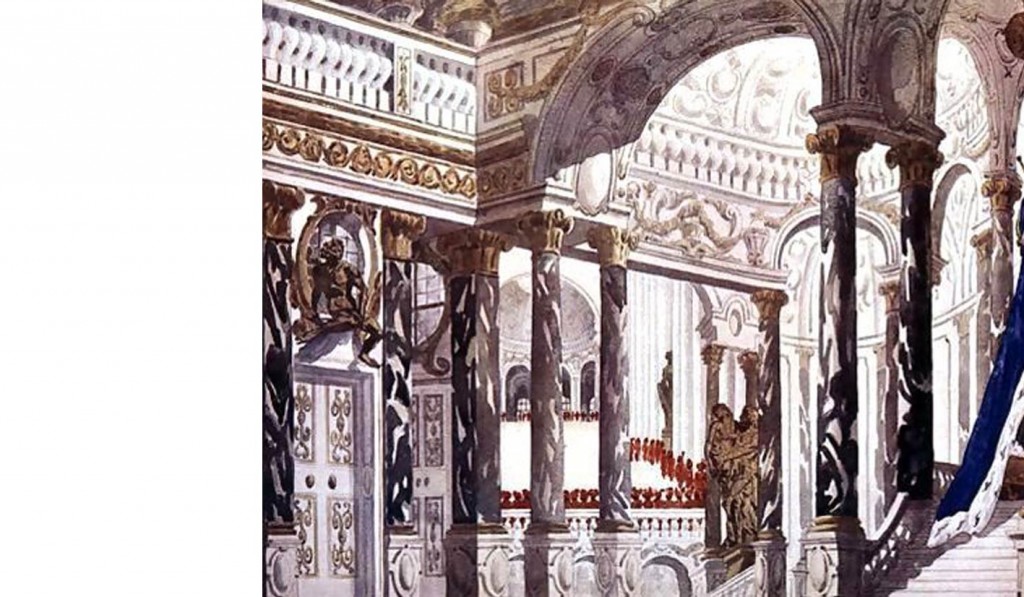
L. Bakst. Sketch for the ballet « Sleeping beauty ».
If we imagine the dimensions of the stage, these are huge areas, at least twice as large as what we see in the portal, from the auditorium. That is, a theater artist is also a muralist. Truly, this is a creative titan.
There are many great theater artists. Maybe they are not as famous in history as painters, sculptors and architects. But contemporaries appreciated them. Have you ever seen the hall applaud the artist while standing? And their work sometimes made such a splash.
The specifics of the work of a theater painter is such that the scenery has a short life. They are designed for huge spaces, have collapsible structures, are stored in warehouses, where they deteriorate and wear out from frequent assembly and dismantling. Of course, sketches, models and costumes remain and settle in museums and collections. Partly by them, we try to imagine the scale of their creations.
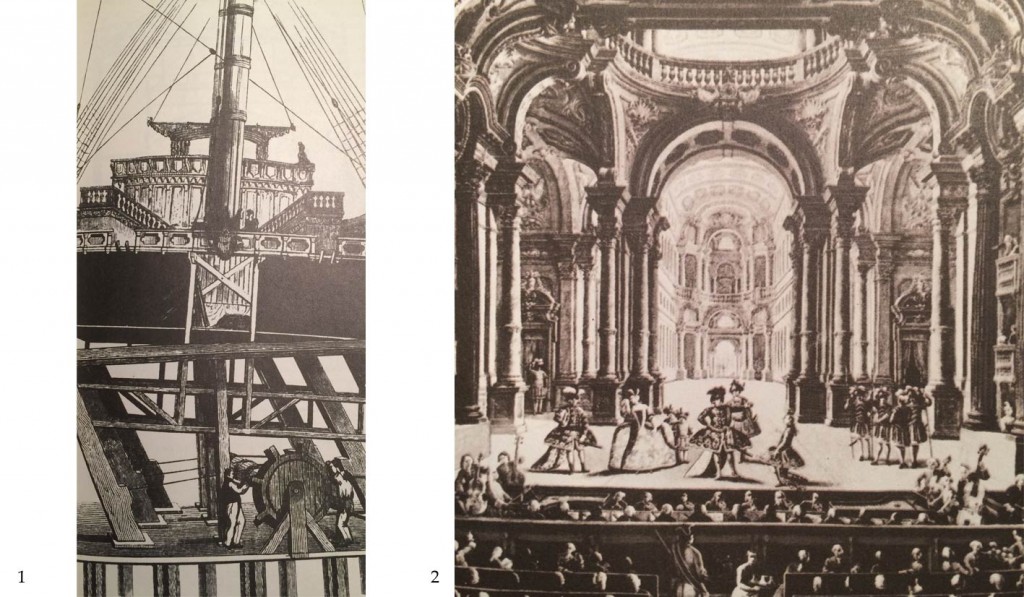
1. Stage mechanism for depicting pitching on a ship. 2. Performance of Oprah in Turin, 1740. Painting by P. Olivero.
Since the beginning of theater in Ancient Greece stage artists created a magical and virtual world without any 3D programs. In the Renaissance, when perspective reigned in art, theatrical backdrops illusory had the depths of entire streets. The Baroque era popularized mobile devices and gave the theater a great spectacle. The sea storm and the flights of angels over the stage were recreated with simple tricks. Today it still titanic work, which is also applauded by the audience.

1. The principle of the device of the heavenly chariot. 1683. fig. Zh Berena 2. A device for depicting a rough sea according to N. Sabbatini. 1639
One of the most iconic figures of the theatrical-artistic world and, in a sense, an unsurpassed artist Leon Bakst said:
“I have often noticed that in every color there are shades that convey sincerity and modesty, and at times sensuality and almost animal qualities, sometimes pride and sometimes despair. All this can be felt and conveyed to the viewer through the effects that various forms produce. This is exactly what I did in Scheherazade. On the melancholy green I layered a dark blue filled with despair, although this may seem paradoxical. There is a red color of triumph and a color of murder. There is the blue color of Mary Magdalene, or the blue of Messalina. An artist who knows how to use this is like the conductor of an orchestra who can set everything in motion with the wave of his wand and produce a thousand unmistakable sounds. Thus, the artist can expect from the viewer that he will feel exactly the impulses that he intends to evoke. * .
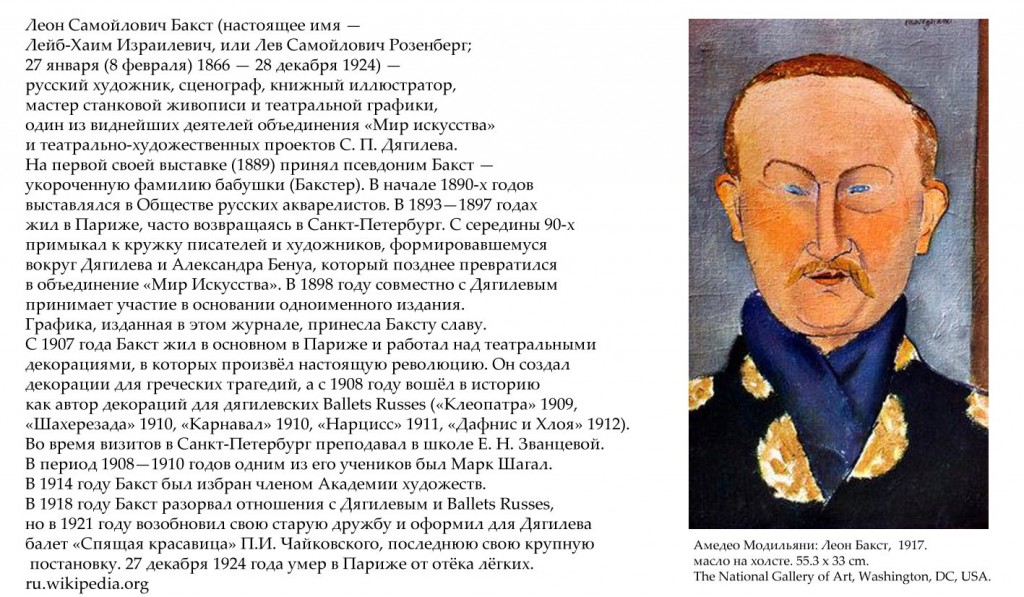
Costume designs for ballets by the Diaghilevskies « Russian Seasons” in Paris fascinate with their energy, passion and riot of colors. These lines are impulsive, they run after the dancer and repeat his movements. Costume fabrics, light or heavy, plain or with ornaments, always complement the character of the characters.
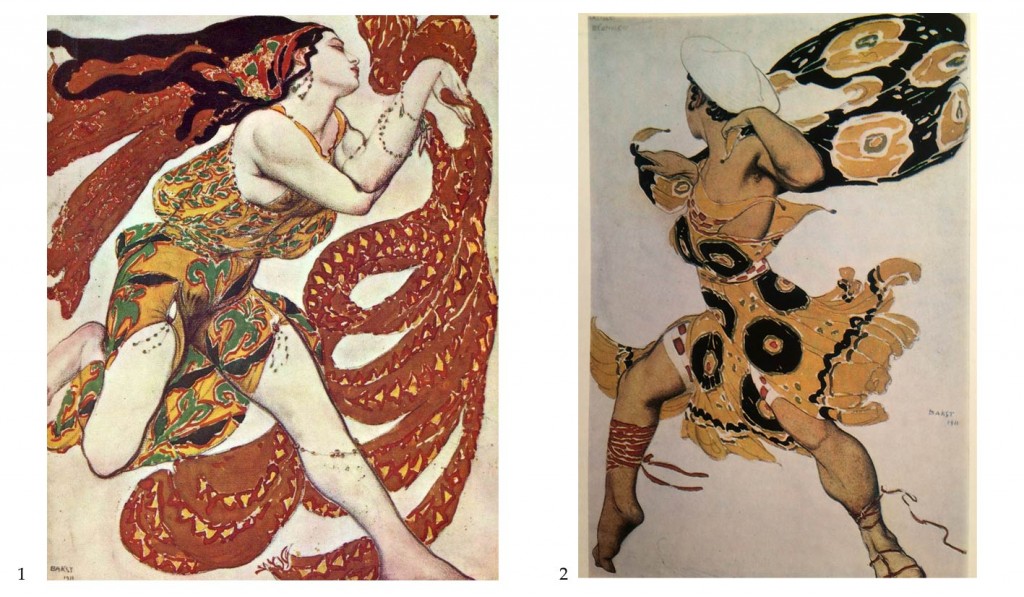
1. Costume design for a Boeotian for the ballet Narcissus 2. Costume design for a Boeotian for the ballet Narcissus, 1911
Leon Bakst studied at the St. Petersburg Academy of Arts, joined the World of Art association, where at one time the most passionate about art and aesthetics people of that time gathered. Completely different, they complemented each other, gave impetus to further creativity, and this was the uniqueness of this phenomenon.
Bakst's work opened up Russian culture and art in Europe and America, together with Diaghilev and the most talented people he gathered around him. With their works, they revived interest in Russian culture and even introduced a fashion for everything Russian.
Being a fairly successful portrait painter, and seeing himself as a painter and graphic artist, it was in set design and costume that he reached the highest peak of his work. And it happened, as it always happens, by chance. He was asked to design a court performance « Fairy of Dolls”, which was supposed to be given once at the Hermitage Theater, as just a light entertainment for the emperor after dinner.

1. Costume design for a Spanish doll for the ballet Fairy of Dolls. 2. Sketch of the postman's costume. 3. Sketch of the scenery for the ballet "Fairy Dolls". 1903
But the production was such a success that it entered the repertoire of the Mariinsky Theater for another 20 years. It was put even after the revolution. From this performance, the artistic life of Leon Bakst as a theater artist began, which brought him worldwide fame.
Alexandre Benois wrote: “In this area, Bakst from the first steps took a downright dominant position and since then he has remained the only and unsurpassed”.
Mstislav Dobuzhinsky wrote about this period: The penetration of art into life through the ramp, the reflection of the theater in Everyday life, his influence on the field of fashion - was reflected in the deep impression that accompanied the brilliant triumphs of Diaghilev's "Russian Seasons" in Paris. The public change of taste that followed these triumphs was due to the greatest extent to Bakst, to those new revelations that he gave in his productions of exceptional beauty and charm, which struck not only Paris, but the whole cultural world West".
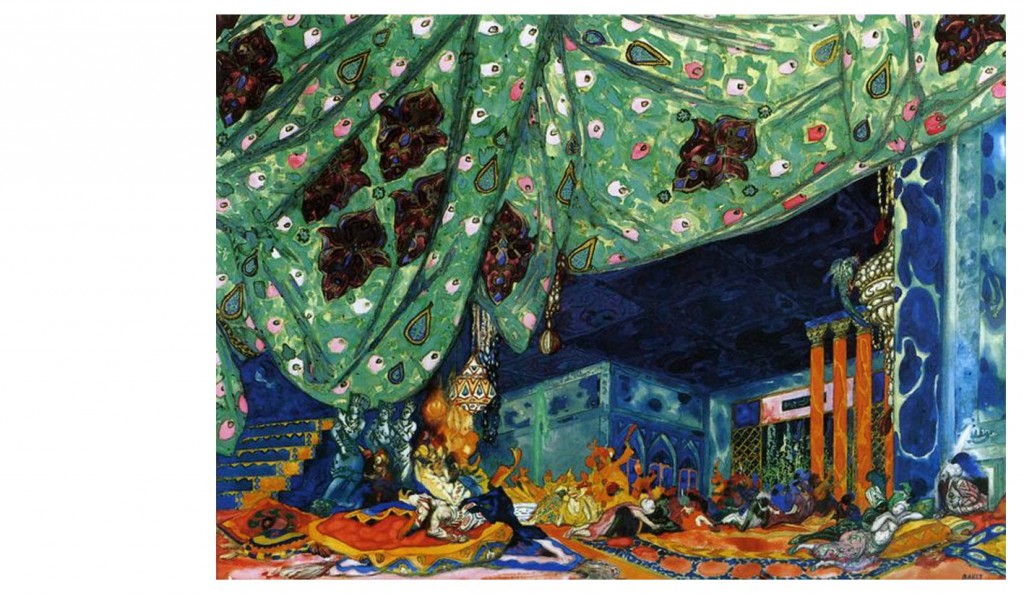
Set design for the ballet "Scheherazade".
“I am looking for nuances rich, magnificent, dazzling,” Bakst said. And he fully reflected this in the scenery of the ballet "Scheherazade". Color played a major role in the design of the performance. Bright red, blue, green and pink tones created the impression of wealth and luxury of the East. The costumes were in harmony with the scenery. Bakst wrote about them: “It is a delusion to think,” said the artist, that costumes win against a neutral background. They acquire a hundred times more power against a bright background. It is only important to be able to coordinate the costumes with the background ".
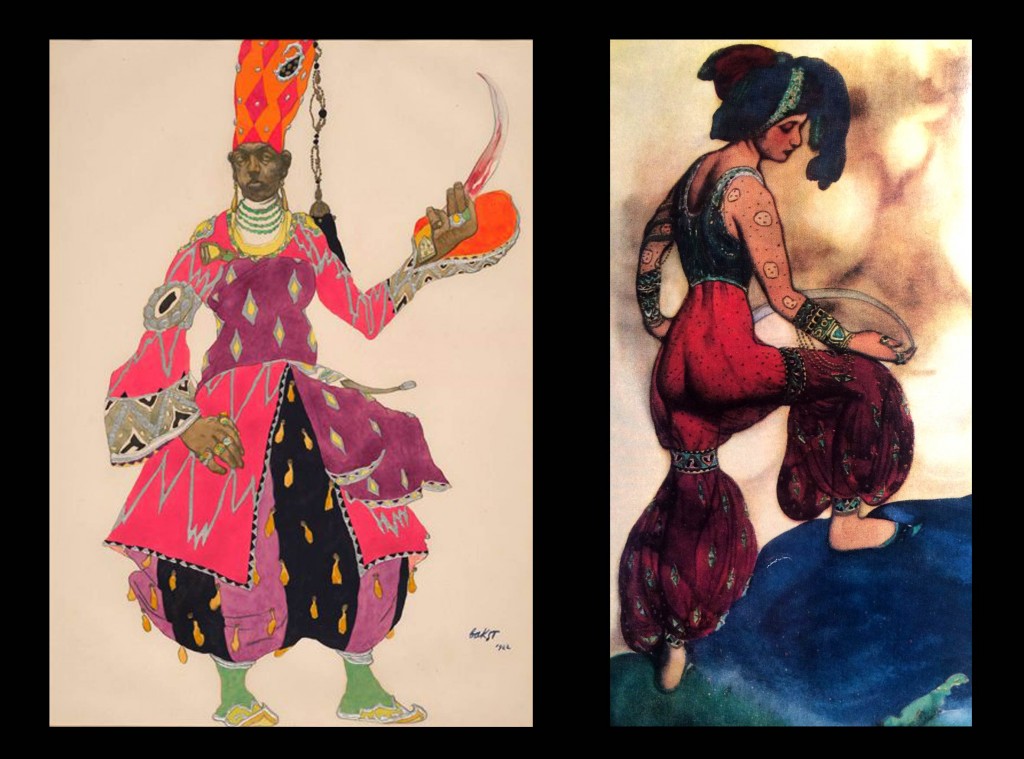

L. Bakst. Costume designs for the ballet "Scheherazade".

Photo of the ballet "Scheherazade".
Besides ballet « Scheherazade » in « Russian seasons » 1909-10, Bakst participated in the production of the ballet « Firebird » to music by the novice composer and student of Rimsky-Korsakov, I. F. Stravinsky. Diaghilev knew how to discover talents. Initially, Lyadov was supposed to write the music, but the work dragged on and the creation of the score was given to the little-known at that time Stravinsky, who did it brilliantly. Fokin worked on the choreography, Golovin was engaged in decoration. His sketches were accepted, but two costumes were not liked - the Firebird and the Beloved Princess. This work was ordered by Bakst.

L. Bakst. Sketches of costumes for the ballet "Firebird".
The outfit of the Firebird was supposed to create the impression of luminous feathers that would illuminate the garden, painted by Golovin in dark blue tones. Usually, ballerinas depicting birds danced in short tutus. On Bakst's sketches, the Firebird was different. Bloomers, a transparent skirt on top, decorated with peacock feathers, a high headdress, richly ornamented. Strings of pearls and gold bracelets complemented the sparkling costume in fiery yellow and orange.
Bakst influenced not only theater artists, for many years, and to this day, fashion designers, designers are inspired by his work and create fashion collections. The then fashion king of Paris, Paul Poiret, bought several of the master's sketches. Outfits a la Bakst appeared in stores. Paris seems to have gone crazy, after the performances, many went even with theatrical makeup on their faces during the daytime.
Erte (an artist of Russian origin who lived in Paris when Bakst worked) admitted that he fell under his influence, and later Yves Saint Laurent, a great fashion designer who also devoted a lot of work to theater and cinema, expressed his admiration for the work of Leon Bakst.
In general, theater artists seem to be a bit of a magical person. They visualize the fantastic world of one creator through their own vision. They surround us with an atmosphere, make us believe that a dramatic work comes to life and leaves the stage in real life. And this mystery is fascinating.
Bakst was just such a force, an artist.
*Interview in the New York Times Tribune, September 5, 1915
Bibliography
1. Golynets S.V. "L. Bakst", 1866-1924.-L., 1981
2. Pruzhan I. N. "Bakst", -L., 1975
The Art Deco style, which rapidly captured all of Europe at the beginning of the last century, also reached Russia. Here, the new trend was called Art Nouveau, and its adherents in the field of painting - World of Art (after the name of the magazine "World of Art", created by a circle of young bohemians, headed by Sergei Diaghilev).
One of the legislators of the new style was Leon Bakst, Leon Bakst - Lev Samoilovich Rosenberg.
Born in provincial Grodno, Lev Samoilovich Rosenberg, in love with the art of painting from childhood, took the name of his grandfather, who lived almost all his life in Paris. Becoming Leon Bakst, he studied with Mark Antokolsky and Valentin Serov, after which he was brought up in the French capital on the work of the French Impressionists. Returning, he became close to the circle Alexandra Benois and his associates. Young artists studied the art of past eras and new trends in the art of Europe. Becoming one of the founders of pictorial decadence, Bakst created portraits of Benois, Diaghilev, later Isadora Duncan, Jean Cocteau, etc. This work did not bring much income, and Bakst taught drawing to the children of the Grand Duke Vladimir, and in 1902, having received an order from the Sovereign, to depict a meeting of Russian sailors in Paris. By the end of the first decade of the 20th century. Bakst focused entirely on work for the theater - he not only acted as a bright theater artist, but also created costumes, for example, for the great ballerina Anna Pavlova.
The pinnacle of his work was the work for the Russian Seasons, which Sergei Diaghilev presented to Europe and the New World in the first and second decades of the last century. Bakst designed the world-famous productions of Scheherazade and Daphnis and Chloe. The painter's work surprisingly combined juicy colors and graphic lines, luxury and sophisticated sophistication. Of course, his work did not find a favorable response in the criticism of the followers of the Wanderers, but the artist nevertheless became a member of the Imperial Academy of Arts in 1914 (regardless of either Jewish origin or Jewish affiliation) and regularly appeared on the pages of fashionable magazines "Apollo" and "Golden Fleece", which today have become a bibliographic rarity in the second-hand book market. However, according to the law of the territorial qualification, Bakst did not have the right to live in the capital, and the artist moved to Paris, where his name sounded absolutely French, criticism was enthusiastic about the painter's works, and the audience went to performances sometimes solely for the sake of the artist's scenery and costumes.
The Chevalier of the Order of the Legion of Honor Bakst had imitators, he was invited to work with the largest theaters and troupes, which first led to tense relations with the Diaghilev troupe, and then to a complete break. His motive was also the fact that at that time the bizarre curves of modernity were replaced by straight lines of constructivism. Art Nouveau came to replace new style- Art Deco - more concise and restrained. And Diaghilev himself, impeccably capturing fashion trends, began to increasingly commission Pablo Picasso's scenery sketches.
After the First World War, Bakst left Europe and moved to work in the New World, where, in particular, he worked for the troupe of the famous dancer Ida Rubinstein and gave lectures. He no longer returned to Russia, and arrived in Paris, recognized by the whole world, a year before his death - in 1923. In 1924, the artist, who was in the prime of his creative powers, suffered a stroke, and his work was continued by his son Andrei Bakst.
The influence of Leon Bakst (along with Diaghilev) on the artistic traditions of the 20th century. hard to overestimate. However, first of all, his art influenced Mstislav and Rostislav Dobuzhinsky, and especially ERTE (Roman Tyrtov), in whose works the key motifs of Bakst's ideas are recognizable. For a long time, working for the American magazine "Harper's Bazar", ERTE made covers in the "Bakst" style. The influence of Bakst on the trendsetter of Parisian fashion at the beginning of the last century, Paul Poiret, who created his collections based on the works of the Russian artist, turned out to be invaluable.
Forgotten in Soviet times in his homeland, Bakst was "rehabilitated" in last years many publications in the press, the release of books and productions by Andris Liepa, who presented Diaghilev's ballets "Scheherazade" and "Games" in the design of Leon Bakst on the stage of the Bolshoi Theater. The apostle of Russian modernity has returned from oblivion.
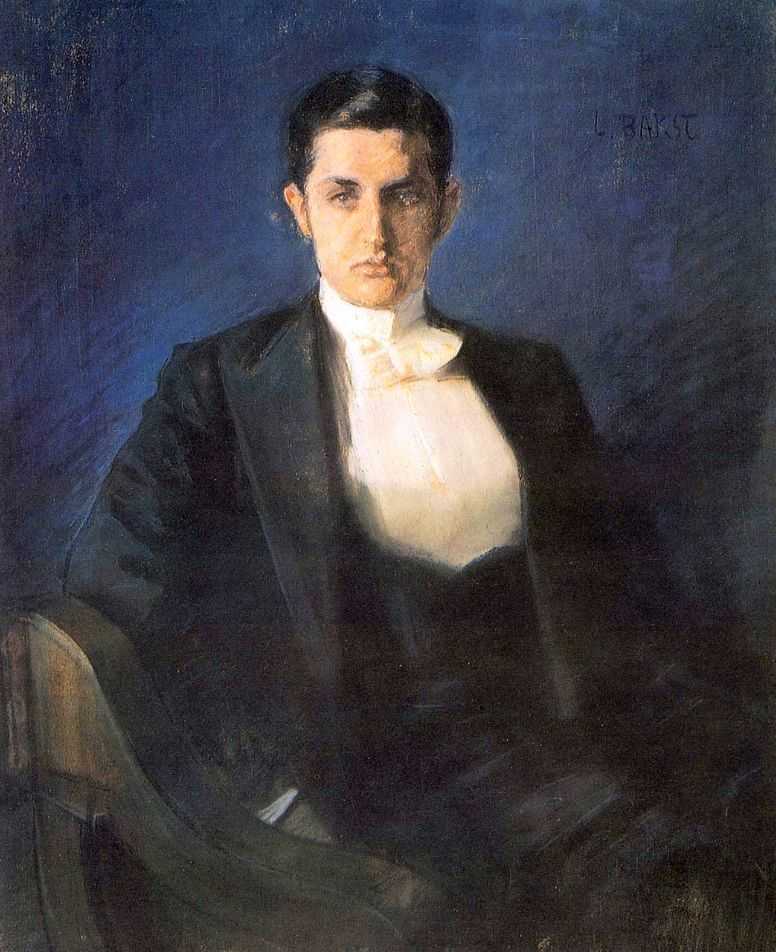
Portrait of Dmitry Filosofov

Dinner
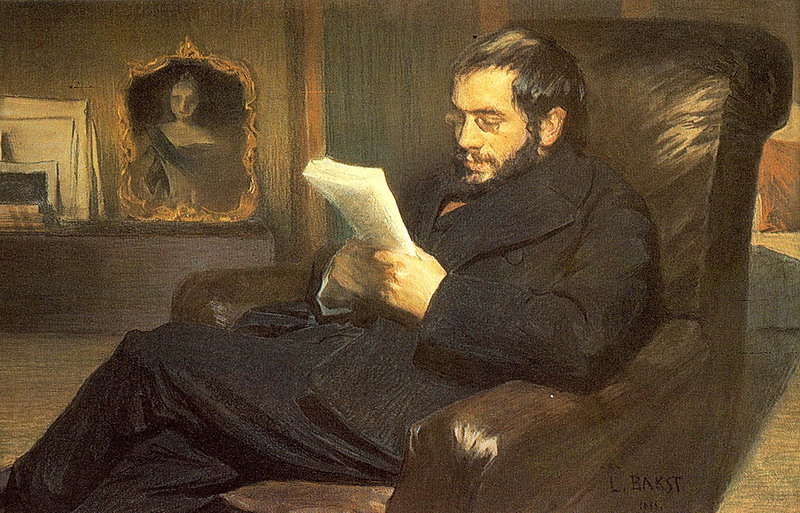
Portrait of Alexandre Benois

Portrait of Andrei Bely

Portrait of Zinaida Gippius
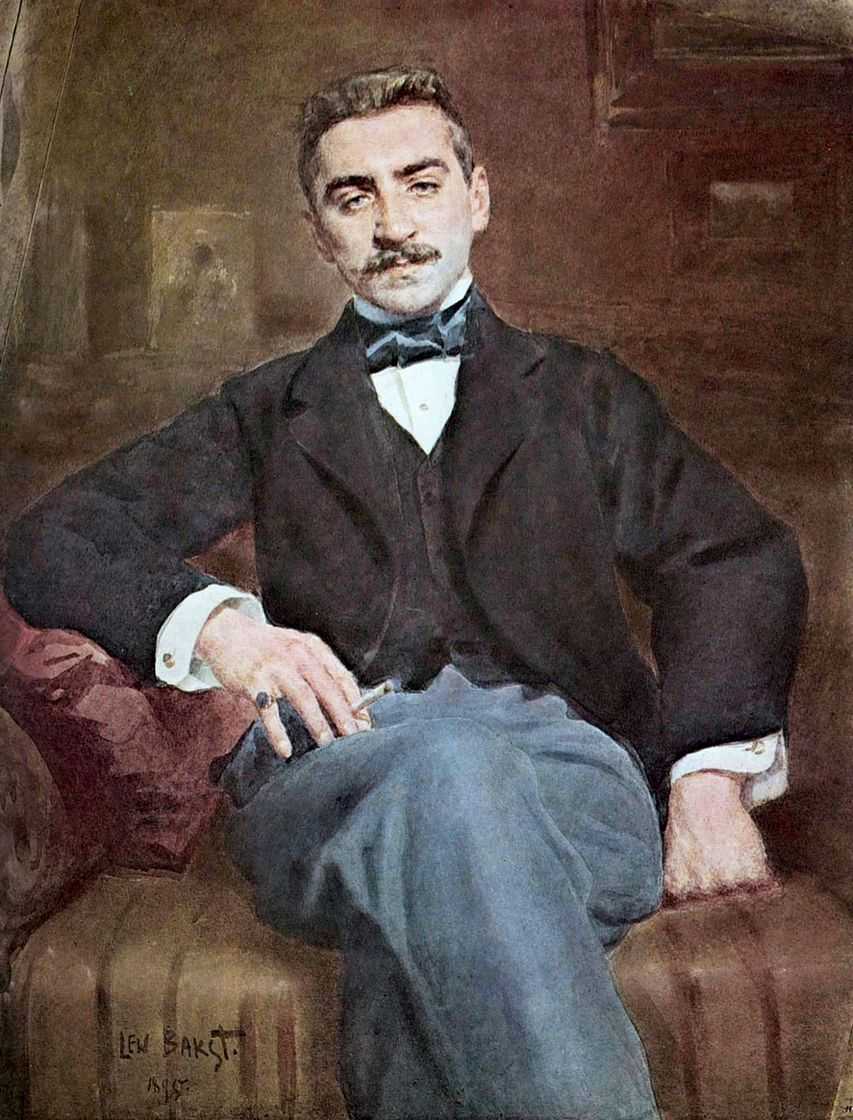
Portrait of Walter Fedorovich Nouvel

self-portrait
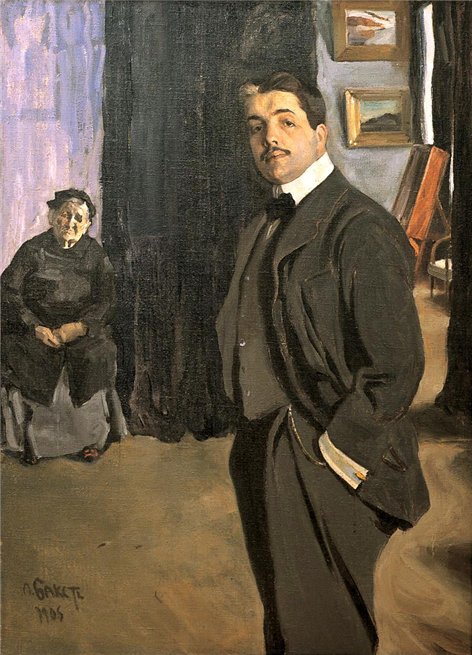
Portrait of Sergei Pavlovich Diaghilev with his nanny

Portrait of the future Countess Henri de Boisgelin
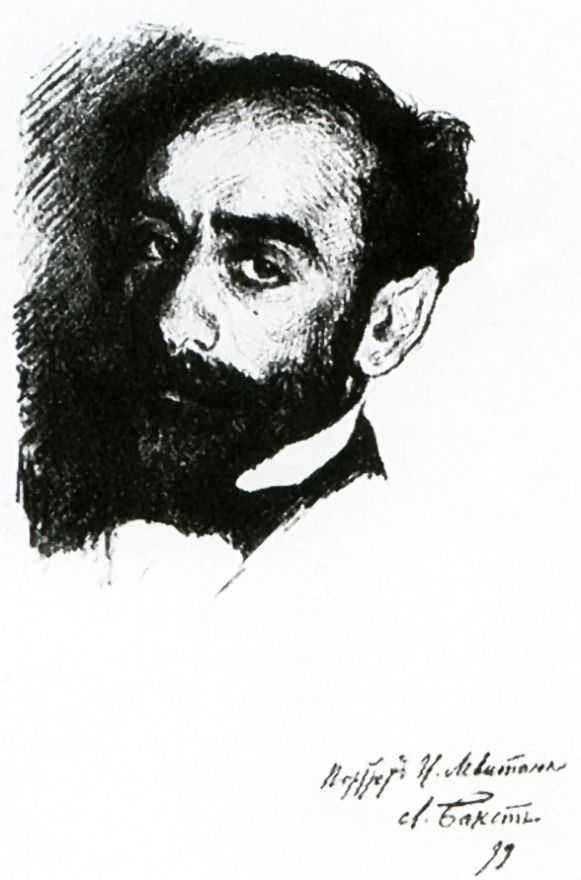
Portrait of Isaac Levitan
Portrait of Countess Keller

Portrait of Princess Olga Konstantinovna Orlova
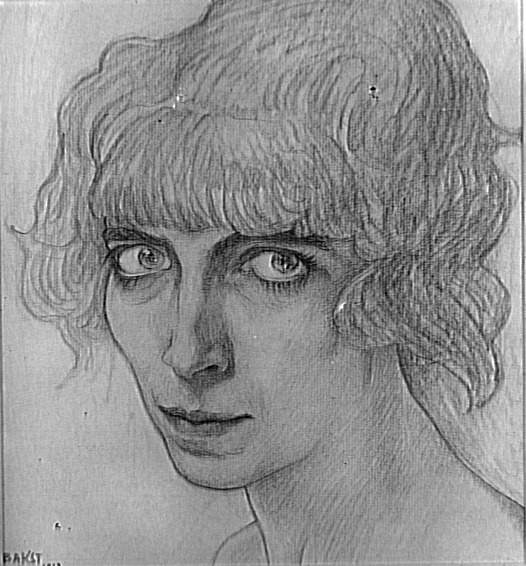
Portrait of a dancer M. Casati
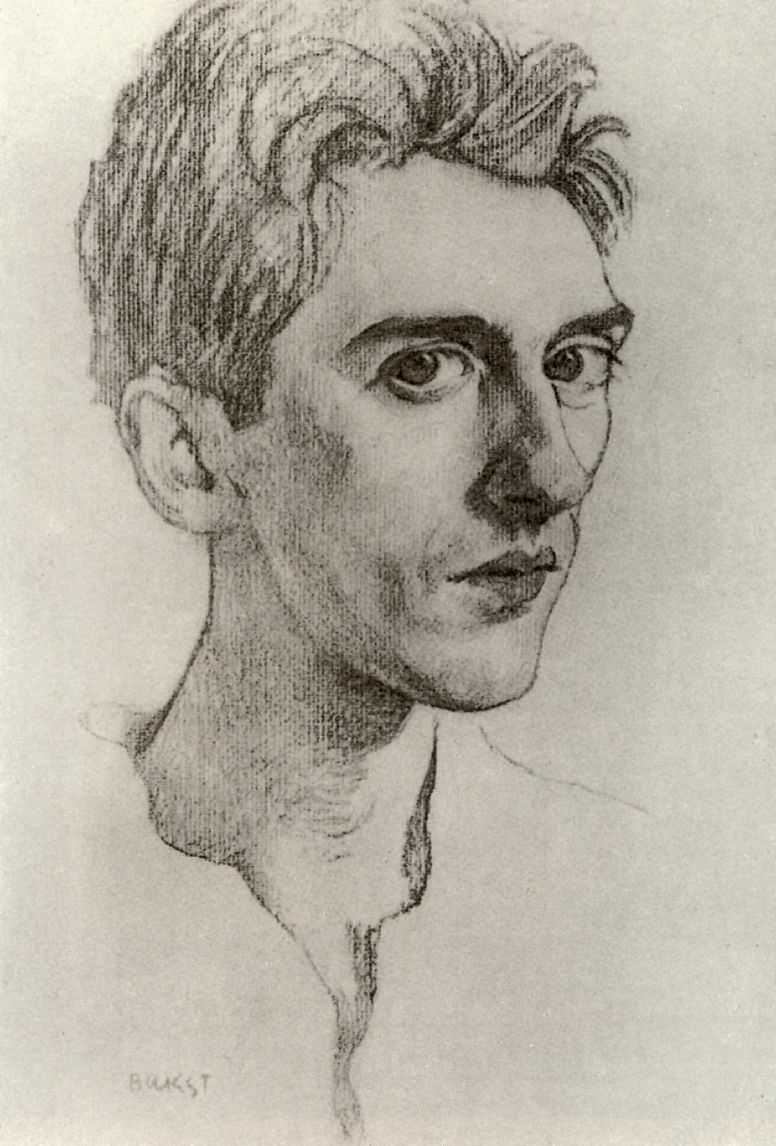
Portrait of Jean Cocteau
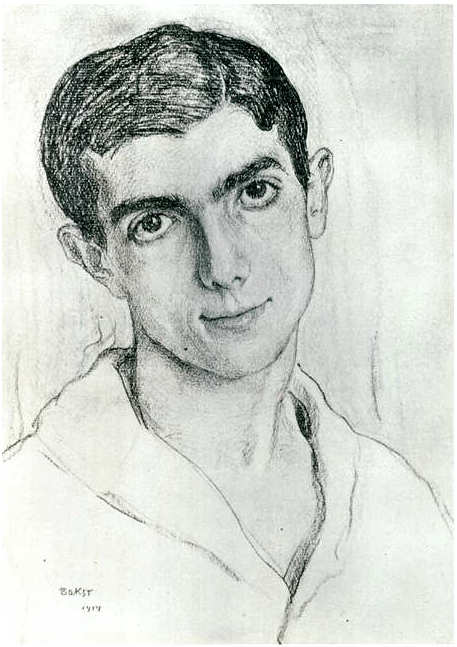
Leonid Massin

Portrait of Maria Markovna Klyachko, the artist's niece

Portrait of the artist's son

Young Dahomean
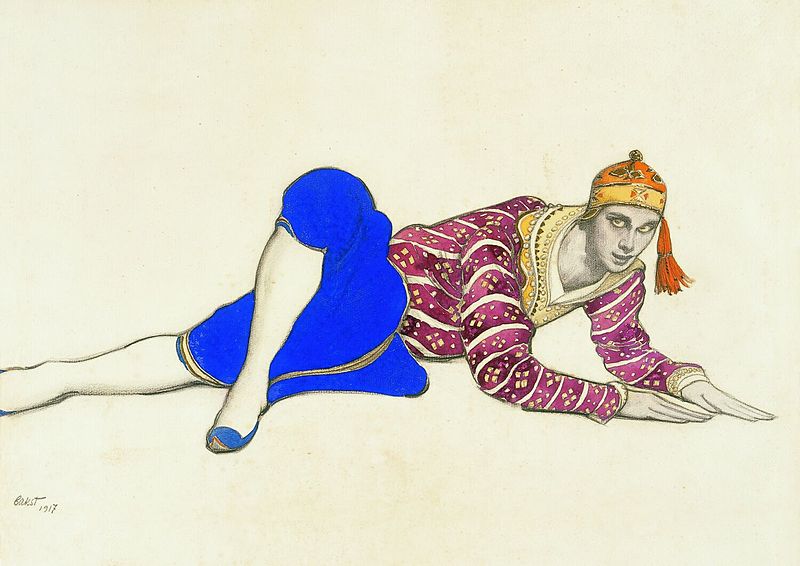
Vaslav Nijinsky as a Chinese dancer

Bakst Lev Samuilovich.
"Sketch of Cleopatra's costume for Ida Rubinstein for the ballet "Cleopatra" to the music of A.S. Arensky"

Costume design for a Jewish dance with a tambourine for the ballet "Cleopatra"

Costume design for the ballet "Cleopatra". Greek dancer
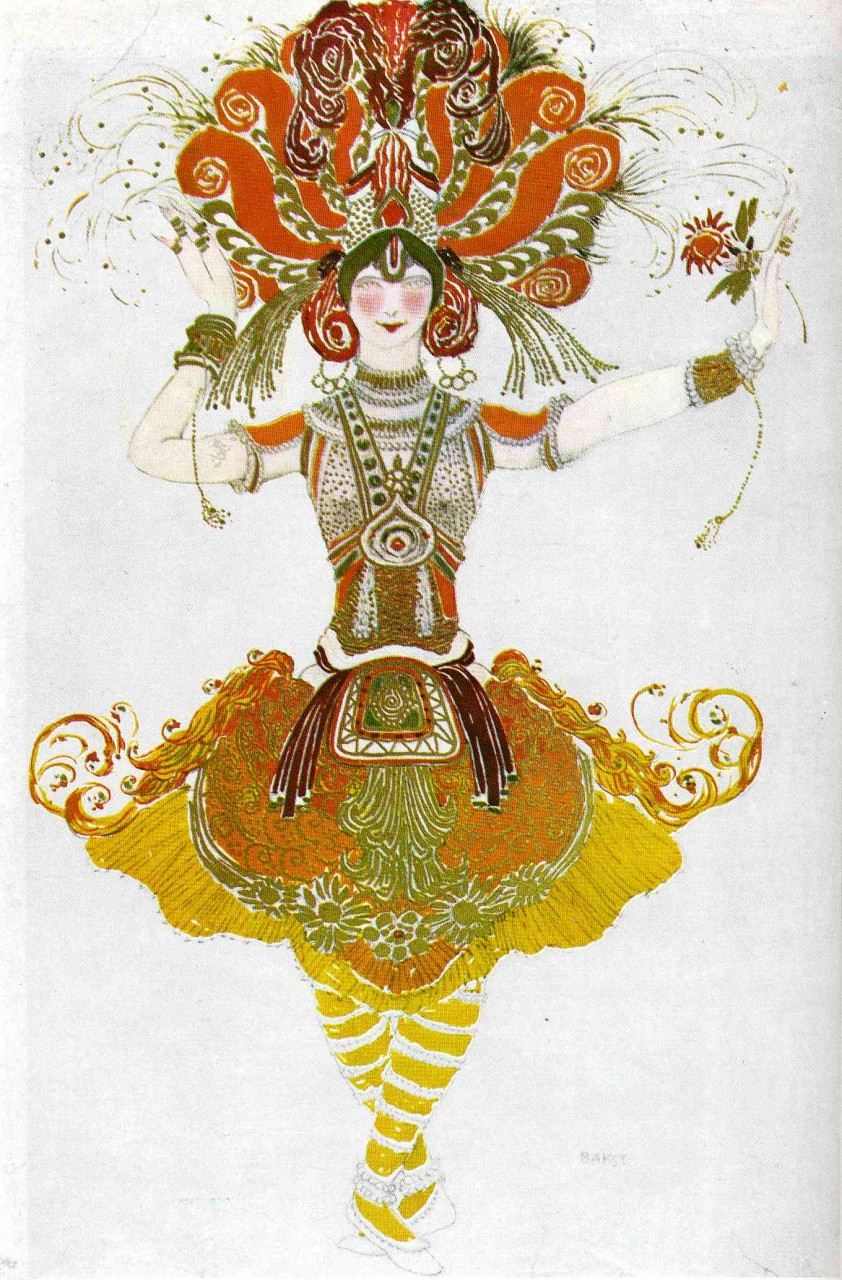
Costume design for Tamara Karsavina for the ballet "Firebird"
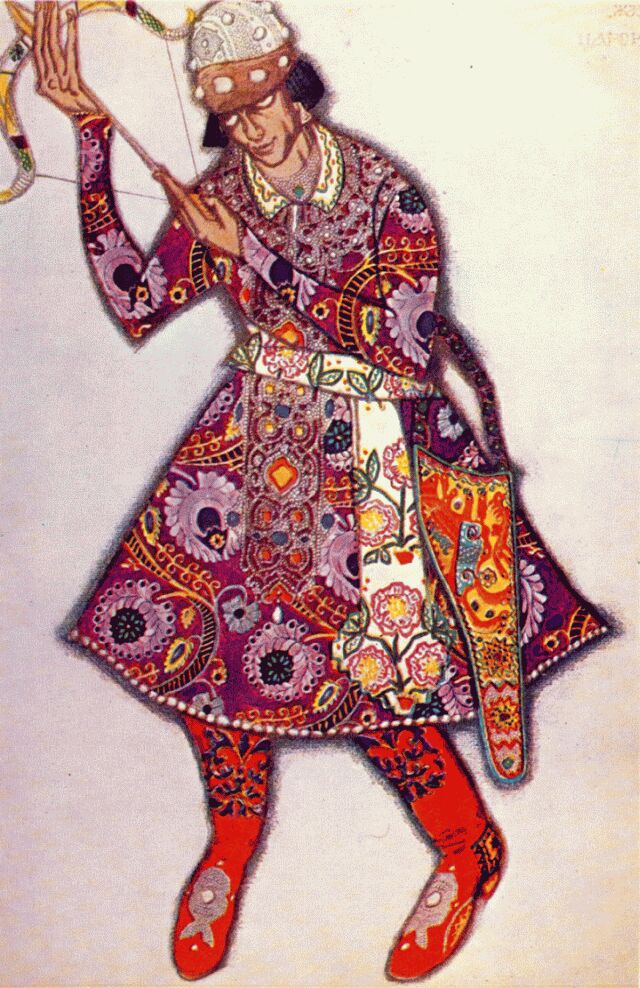
Costume design for the ballet "Firebird". Mikhail Fokin as Tsarevich

Costume design for the ballet "Firebird". Princess

Costume design for the Firebird

Costume design for the ballet "Scheherazade"
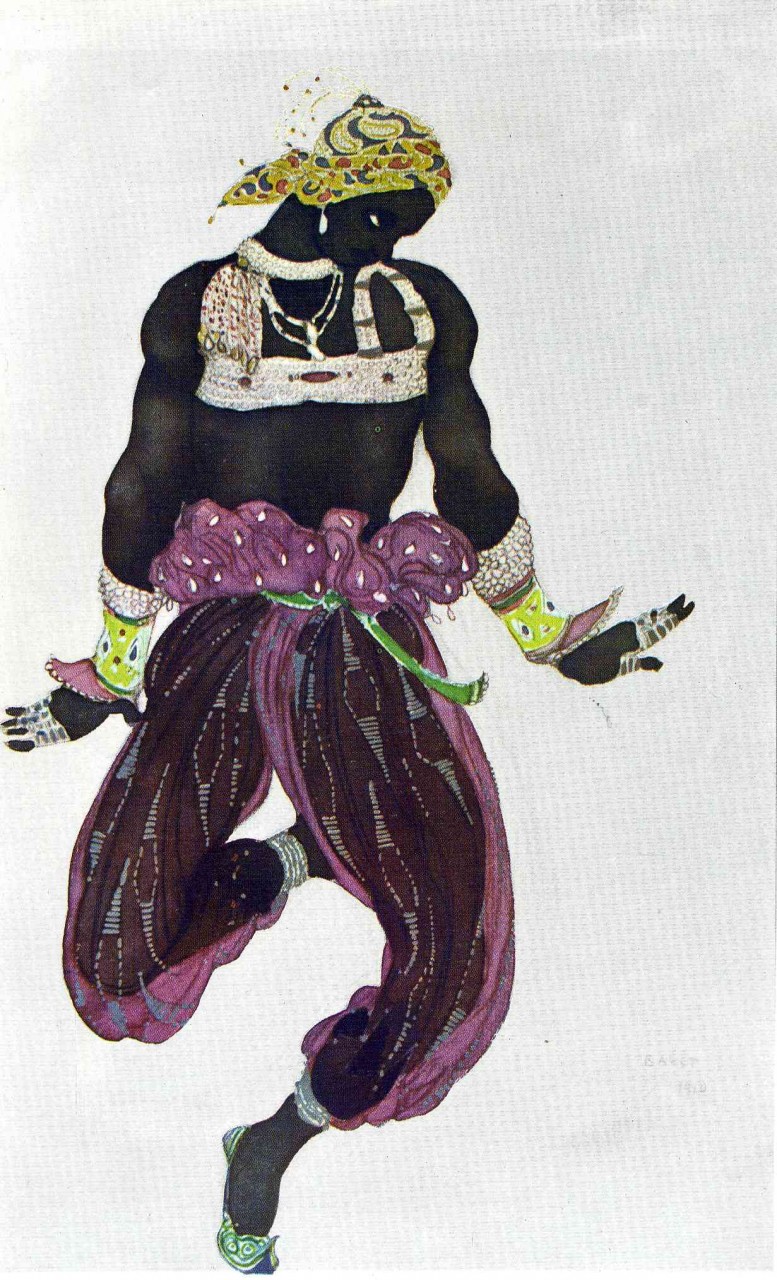
Costume design for the ballet "Scheherazade". Silver Negro
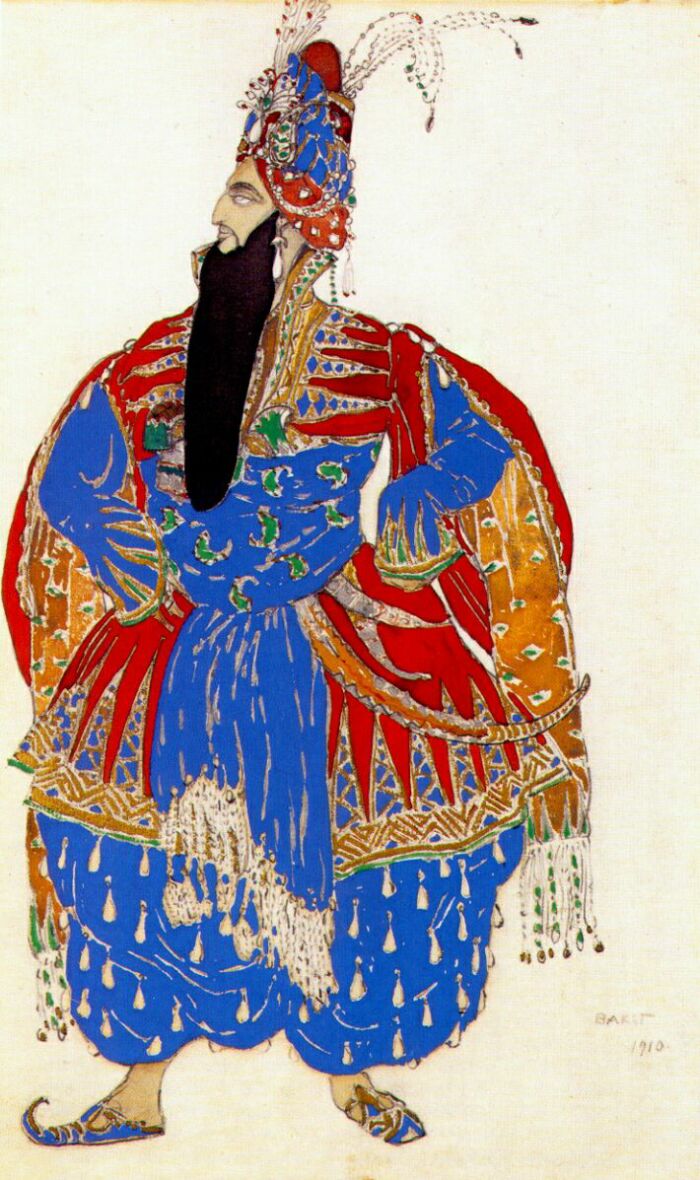
Costume design for the ballet "Scheherazade". Shah Shahriar
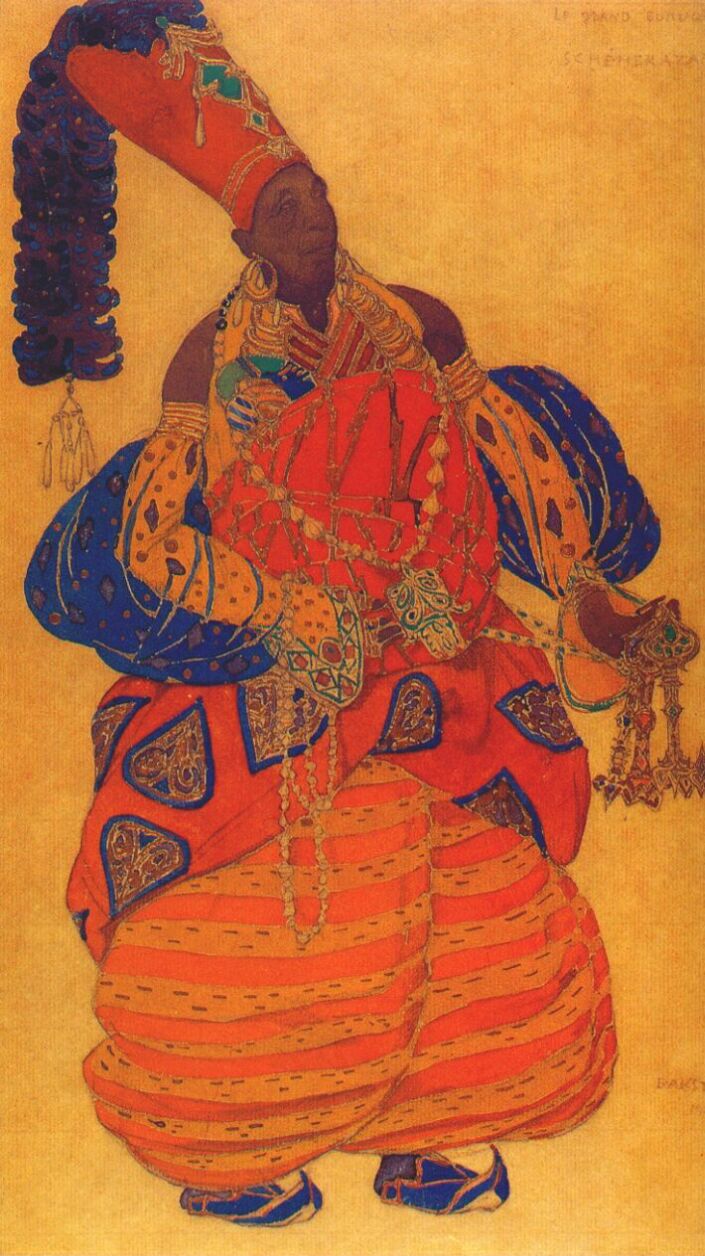
Costume design for the ballet "Scheherazade". Chief Eunuch

Costume design for the ballet "Scheherazade". Odalisque

Bacchante
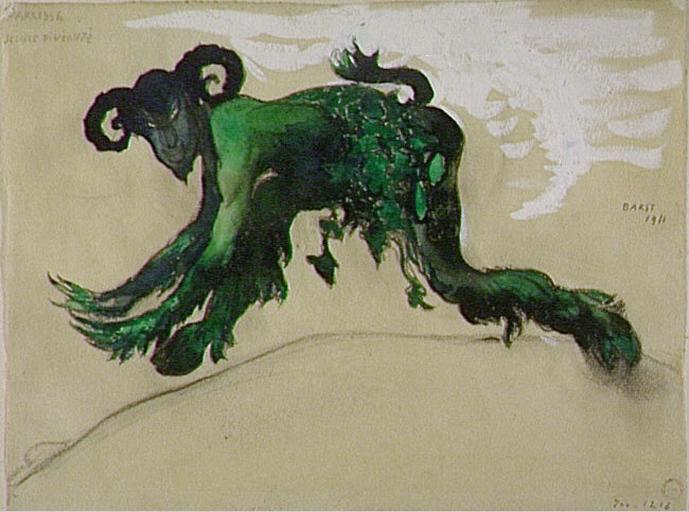
Costume design for the ballet "Narcissus"

Costume design for the ballet "Narcissus"

Costume design for the ballet "Narcissus"
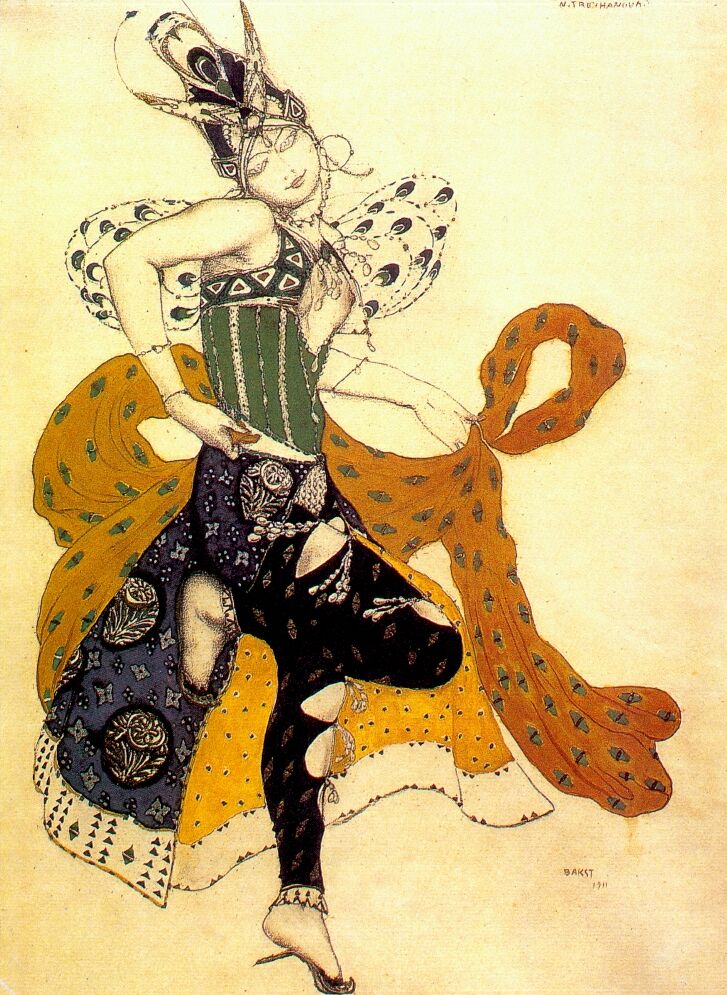
Costume of Natalia Trukhanova as Peri
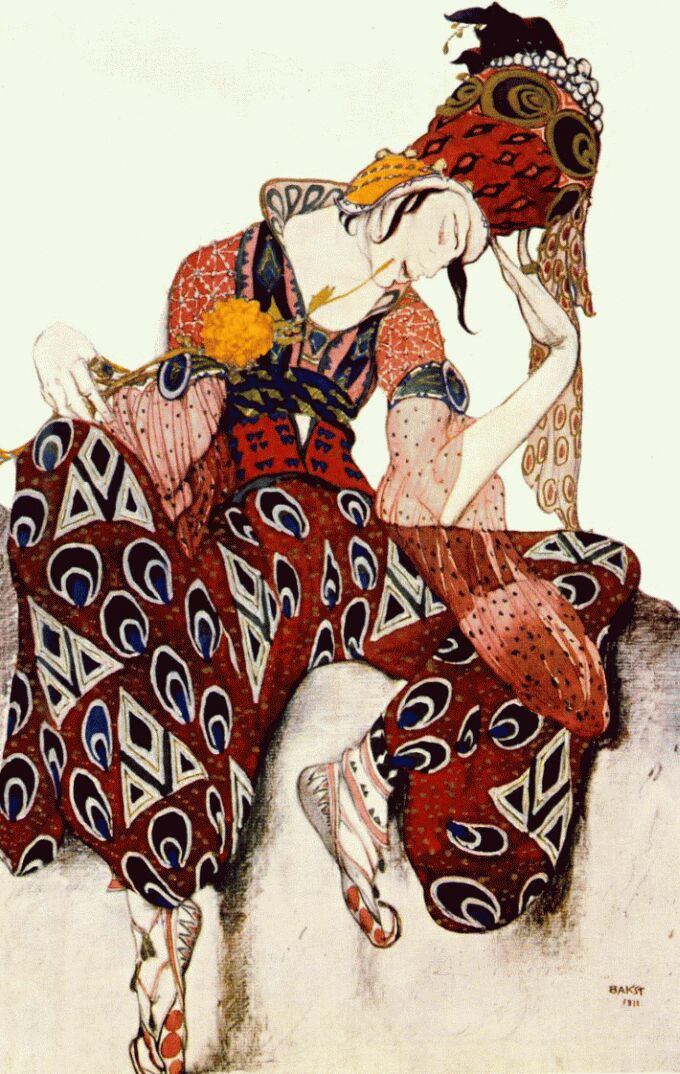
Vaslav Nijinsky in Peri's ballet

Costume design for the ballet "The Blue God". Vaslav Nijinsky in the title role

Costume design for the ballet "The Blue God". bayadère
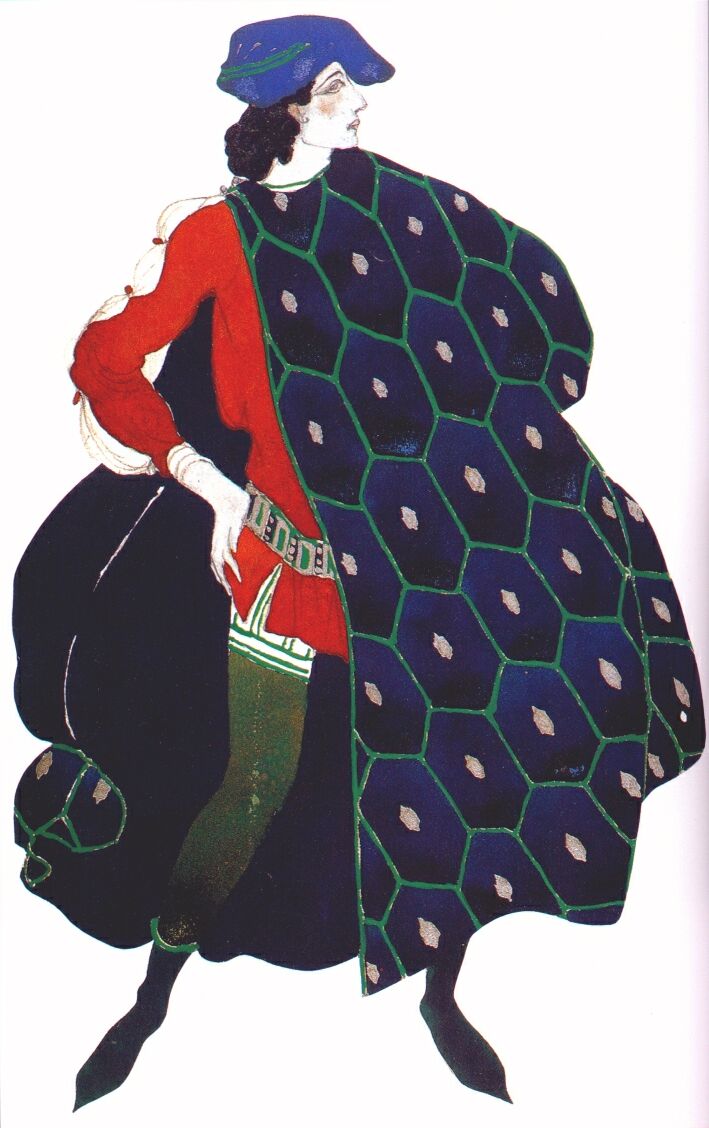
Costume design for the ballet "The Martyrdom of Saint Sebastian". Ida Rubinstein as Saint Sebastian
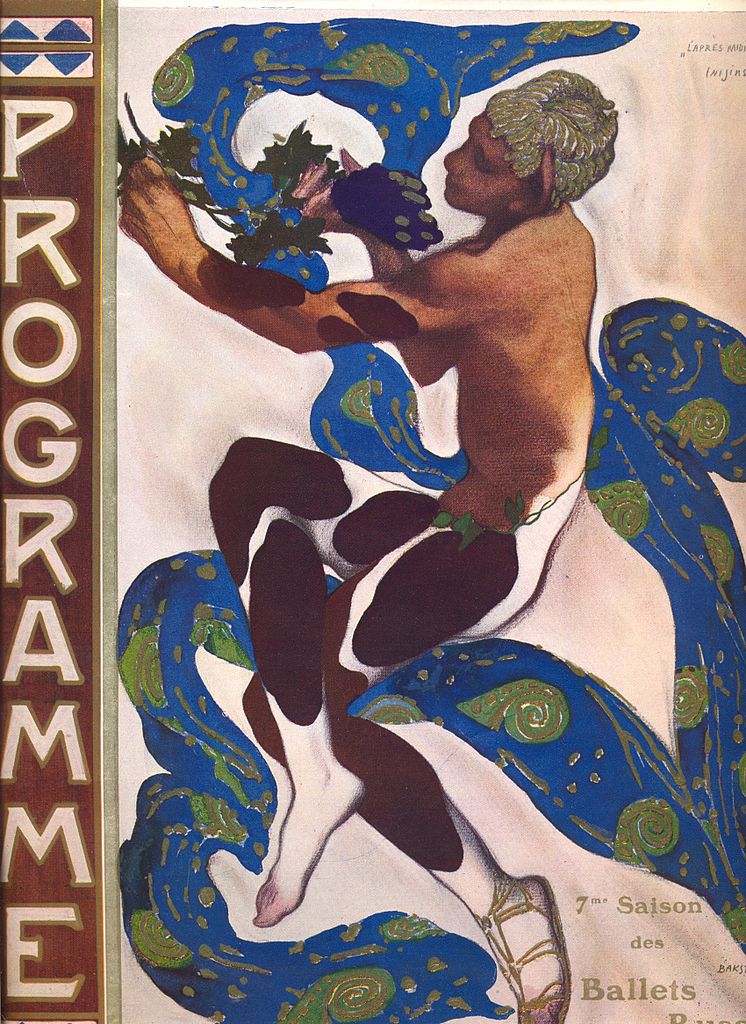
Costume design for a Faun for Vaslav Nijinsky for the ballet "Afternoon of a Faun" - cover of the program for the Seventh Season of "Russian Ballet"

Sketch of a woman's dress
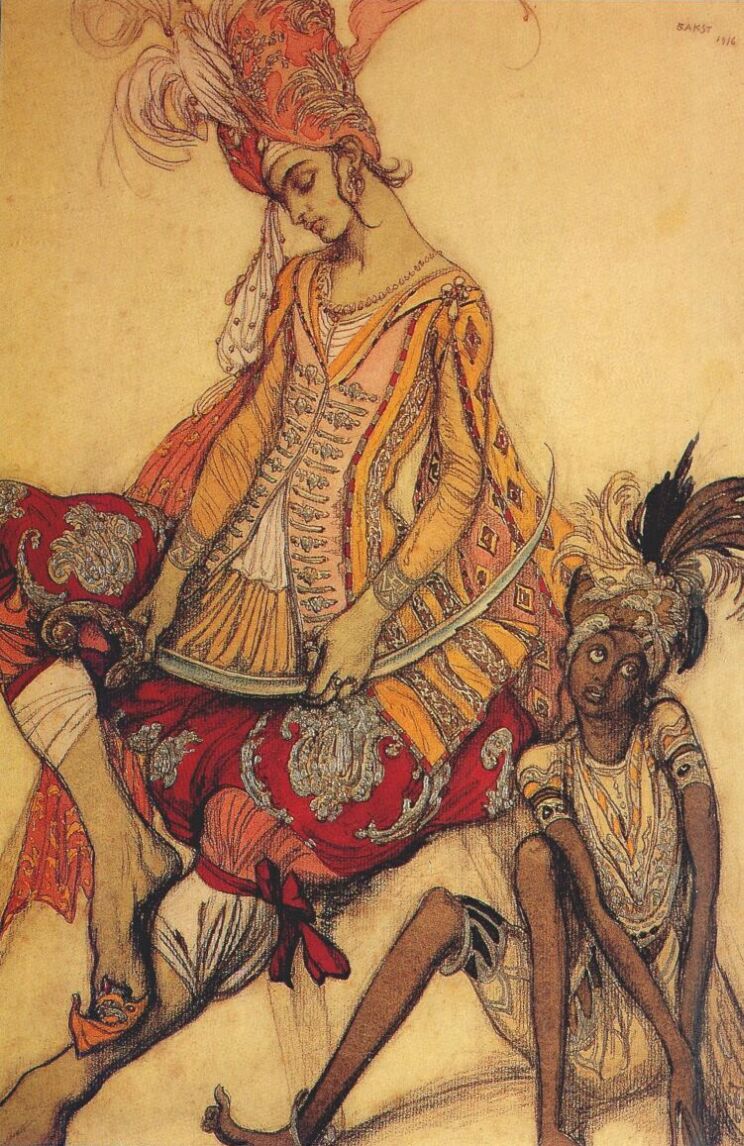
sketch of a costume for the ballet "Sleeping Beauty". Oriental prince and his page

Ida Rubinstein as Ishtar
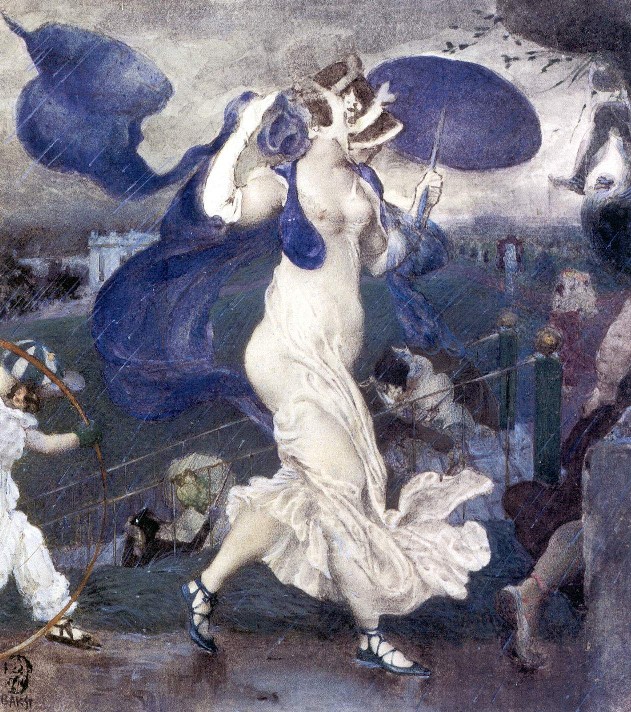
Leon Nikolaevich Bakst (real name - Leib-Khaim Izrailevich, or Lev Samoilovich Rosenberg; 1866-1924) - Russian artist, set designer, book illustrator, master of easel painting and theater graphics.
Biography of Leon Bakst
Lev Rosenberg was born on February 8 (January 27), 1866 in Grodno in a poor Jewish family of a Talmudic scholar. After graduating from the gymnasium, he studied as a volunteer at the Academy of Arts, moonlighting as an illustration of books.
At his first exhibition (1889) he adopted the pseudonym Bakst, a shortened surname of his grandmother (Baxter). In the early 1890s, he exhibited at the Society of Russian Watercolorists. In 1893-1897 he lived in Paris, often returning to St. Petersburg.
From the mid-1990s, he joined the circle of writers and artists that formed around Diaghilev and Alexander Benois, which later turned into the World of Art association.
Creativity Bakst
In 1898, together with Diaghilev, Leon took part in the founding of the publication of the same name. The graphics published in this magazine brought fame to Bakst.
He continued to engage in easel painting, creating portraits of Malyavin (1899), Rozanov (1901), Andrei Bely (1905), Zinaida Gippius (1906). He also taught painting to the children of Grand Duke Vladimir.
In 1902, in Paris, he received an order from Nicholas II for a meeting of Russian sailors.
In 1898, Bakst showed his work at the "First Exhibition of Russian and Finnish Artists" organized by Diaghilev; at exhibitions of the "World of Art", at the exhibition "Secession" in Munich, exhibitions of the Artel of Russian Artists.
In 1903, he converted to Lutheranism for the sake of marriage with the daughter of P. M. Tretyakov, L. P. Gritsenko.
During the revolution of 1905, Bakst worked for the magazines Zhupel, Infernal Mail, Satyricon, and later in the art magazine Apollo.
Since 1907, Bakst lived mainly in Paris and worked on theatrical scenery, in which he made a real revolution. He created scenery for Greek tragedies, and since 1908 he went down in history as the author of scenery for Diaghilev's Ballets Russes (Cleopatra 1909, Scheherazade 1910, Carnival 1910, Narcissus 1911, Daphnis and Chloe 1912). In 1910 he divorced Gritsenko and returned to Judaism. All this time he lived in Europe, because, being a Jew, he did not have a residence permit outside the Pale of Settlement.






